PASINI REPORTS: PMA TRADE SHOW
We Make a Few Connections
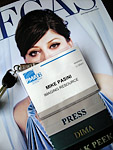 By MIKE PASINI
By MIKE PASINIEditor
The Imaging Resource Digital Photography Newsletter
LAS VEGAS -- We began our second day of coverage in the press room. But just as we got there, we were accosted (there's no other word for it in English) by O'Reilly author and photographer Mikkel Aaland. After a round of outrageous claims and sincere denials, he made the outlandish assertion that his home page is none other than our own Imaging Resource (http://www.imaging-resource.com).
To prove it, he whipped out his 17-inch PowerBook, booted it up and brought up Safari with, yes, Imaging Resource as the home page. We were not only impressed with his taste, but even more impressed by just how many browsers he must have on that laptop. There must have a homepage for everyone.
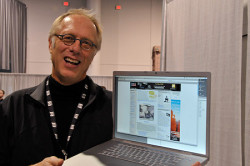
Aaland Home Page? It's Imaging Resource!
Mikkel was on his way home, but we were just hitting the floor, so we said goodbye and got to work making more connections.
One connection that has eluded us is a simple way to use those cheap little plastic hooks on our dSLRs so we can just snap a shoulder strap or a wrist strap on and off without rethreading anything. Op/Tech does make a system for that, but we just wanted a little plastic hook large enough to accommodate those cheap snap hooks that don't fit in dSLR eyelets.
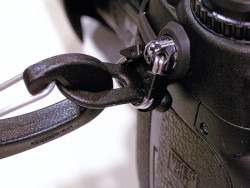
Adapt-It. It's the missing link between the camera strap hook and the camera eyelet.
Our day has finally come. Op/Tech has invented the Adapt-It, an easy to attach, non-marring connector that's very compact. It's made out of the same stuff as car bumpers, so heat and cold don't bother it. And it's tough, stretching to two or three times its normal length before breaking. And that takes about 100 pounds of tension.
The company plans to sell them in packs of four for about three or four dollars within a week.
GE HDMI DIGICAM | Back to Contents
We were delighted (and a bit surprised) to find an HDMI port in Nikon's D300 but we were flabbergasted (hey, it passed my spell check) to see an HDMI port in a digicam.
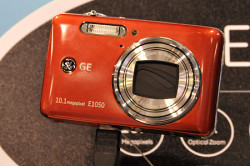
USB Not. That's an HDMI cable plugged into the bottom of this GE.
But why not? HDTV isn't high resolution compared to even a modest digicam sensor these days. And looking at downsampled VGA images on your HDTV is nearly insulting. To the TV, to the photographer, to your subject.
So GE has popped one into its $249 E1050, which will hit the stores in March. Bright idea, GE.
But if you can wait until September, the same digicam will include the Geotate (http://www.geotate.com) built in GPS device we discussed in our Sneak Peek report (shttp://www.imaging-resource.com/EVENTS/PMAS08/MRP/sneakpeek.htm#geo).
We are not quite yet shopping around for a cane, but the idea of a walking stick with a camera mount on top appeals to us. Even an image stabilized lens could use a little help now and then, we think.
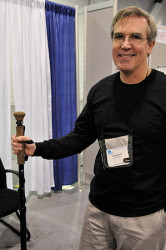
Jim Clark. The inventor of magnet mounts on walking sticks with legs.
Jim Clark, CEO of Trek-Tech (http://www.trek-tech.com) took the trouble to invent just such a walking stick and camera mount. His camera mount, however, is magnetic. And his walking stick actually spreads its bottom segment into three legs so it can stand up unaided. And not only that, but it comes apart in sections that fit into a convenient carrying case so you can take it anywhere with you.
The company makes a number of interesting accessories, in fact. Clever ideas that nearly any photographer would be happy to have in their kit.
The $50 MagBag, for example, resembles a bean bag support but it has a steel washer in it to hold a MagMount screwed into the tripod socket of any camera. And instead of beans, there's a plastic bag inside that you can fill when you arrive at your location, rather than haul beans all over creation. It even includes a waterproof ground cover/rain bibby.
And the $30 Cammock, a three-cornered pouch, attaches to your tripods legs so you can stabilize the tripod with a little extra weight. The Cammock even opens up into a flat, waterproof ground cover/rain bibby, too.
Not far from Trek-Tech we ran into Ivan Randall, product marketing manager for Merax (http://www.merax.com). He, too, had a GPS device, the PhotoFinder GPS.
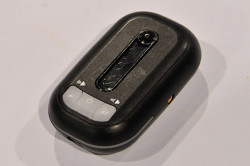
PhotoFinder GPS. The software is half the story.
We caught Ivan's act at Macworld Expo where he was pushing the One Shot Photo Studio, a clever little product we found a little underdesigned (not enough light). But he made the most of its virtues and we applauded his act.
At PMA, he had a classier product to hawk. The PhotoFinder GPS is a small device you can leave in your pocket that is constantly grabbing GPS data off the satellite for three weeks until its 4-MB buffer fills.
When you transfer your photos to your computer, you can also download that buffer of GPS data. The company's software finds a match between your images and the GPS data using date/time information (which need not be synchronized). That data is then written to the Exif header of your image files.
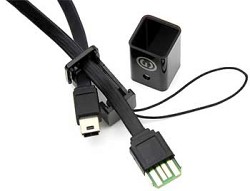
Mini USB Strap. A wrist strap that converts into a USB cable.
Of course, it's the software that makes this date/time sync feasible. Where other GPS devices have to be mounted on a hot shoe and triggered by the shutter, the PhotoFinder GPS is always tracking your location and only worrying about when the shots were taken later.
It's powered by a rechargeable lithium-ion battery (much like a cell phone) that goes about three weeks on a charge.
The company also sells the $10 Mini USB Strap, which incorporates a 9.5" USB cable (has standard USB Type A for the USB port on your computer and a USB mini B connector on the device end) into a non-slip loop wrist strap. Very clever.
We sat down with HP (http://www.hp.com) for a 45 minute discussion of its latest print technology. There's a new aggressiveness about the company since Kodak launched its pigment-based all-in-ones. Hey, it seems to be snarling, we invented this stuff.
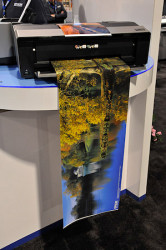
Epson R1900. Need to print on roll paper? This is your boy. Want to print 13x19 black and whites? The HP B8850 is the ticket.
We like a good fight (as long as everyone fights fair) and one arena we're seeing blows exchanged is in the amateur 13x19-inch printer market. Epson's R1900 and HP's B8850 are in that ring with their gloves off.
We discussed them both in our Macworld Expo report (http://www.imaging-resource.com/EVENTS/MWSF08/mw-tue.htm) and reported on the HP again in our Sneak Peek report (http://www.imaging-resource.com/EVENTS/PMAS08/MRP/sneakpeek.htm).
In the latter, we learned which high-end features have been jettisoned from the B9180 to build the less expensive B8850. Those include Ethernet (it's USB 2.0), software RIPs, the ability to handle thick and stiff media (although it does handle specialty media like canvas). There's also no LCD display and no 16-bit color support. All that reduces the cost $150.
But we learned a few more things in our chat with Product Manager Ron Forster.
For example, the B8850 maintains itself much like the B9180. The B9180 is intended for professional use (rather frequent, that is) while the B8850 is clearly going to be idle for weeks at a time. You really have to unplug them to completely turn them off because even when you power them down, they will evaluate their printhead nozzles every 24 hours (based on when you first powered them up).
The evaluation is done off the printing area by firing a small droplet of ink through each nozzle. A sensor detects the charge on each droplet and if it doesn't like what it sees, it can temporarily remap a clear nozzle to the clogged one before taking the time to clean the nozzle.
That may sound like a lot of ink flushing through your printer every 24 hours, but HP has calculated a roughly 10:1 advantage in ink usage doing it their way.
The savings don't stop there, though. Anything you print that's 5x7 or larger is cheaper than the equivalent enlargement from a photo lab, Ron told us. And that, after all, is why you buy a large printer. The big prints.
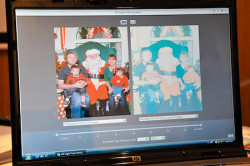
HP Light Fade Simulator. See what your combination of paper and ink will look like in 75 years. Or even next year.
Tom Brown showed us an interesting application that could be the knockout punch for HP. The HP Light Fade Simulator is a free downloadable application for Windows that's a print time machine. Select one of your images (or one of the 10 included images) and it will appear twice on the monitor with a pulldown menu under each image.
The menus let you select which combination of paper and ink to "print" your image with. You can use HP's products or some superstore brand. There's quite a variety of choices.
Under that is the time slider. As you select the number or years since the images were printed, the program simulates the effect of their aging.
Tom told us HP used Wilhelm Research's methodology in calibrating the degree of fade each year, building a different ICC profile for each year.
The point of the exercise is to demonstrate the permanence HP paper and ink deliver compared to less expensive third-party brands. In the store, the lower price tag may be compelling, but when you see what you're not getting, you may think twice.
The company also introduced some new large format print papers for print service providers and creatives. Product Manager Jeanette Volk showed us two microporous sheets designed for its pigment inks.
The Everyday photo papers run about 25 cents per square foot in 100 foot rolls of 24/26/42/60-inch widths. We saw both a gloss and a stain finish.
Joining them was a premium matte paper that can handle 300 percent coverage in 24/36-inch wide rolls of 100 feet.
Both papers will be available in March.
FILM RESCUE | Back to Contents
Some connections need rescuing. And if anything in this digital world needs rescuing, it's film. And we found just the place to do it: Film Rescue International (http://www.filmrescue.com).
We stopped in our tracks when we saw their literature illustrated with Kodak disc film. They can take care of your Instamatic film, too, scanning these antique formats at an affordable price.
Oh, forgot to develop that old film? No problem, that's the mainstay of their business. If they can't get an image out of that film, they don't charge you.
FAME, FORTUNE, FLORIDA | Back to Contents
Having a past is, no doubt, a prerequisite of making a connection. But what if you don't have a past? What if -- horrors -- you're a college student, say?
Well, you just have to enter a contest.
Sponsored by Xerox, Fujifilm, H&H Color Lab and Adobe, the MyShot08 Student Applied Digital Photography Print Awards are open to registered college students 18 years and older. It could, according to them, be your big break.
The contest runs until March 31. To enter, just set up a free account at http://www.MyShot08.com.
Oh, the prizes, Hilda, the prizes. Photographer (and lead judge) George Kamper will take you with him to Miami for a photo shoot. Or you could win $3,000. Or a Fujifilm infrared camera. Or some Adobe software to be named later. But you at least get one free print of your work.
And that is the last connection we're making in this report. Time to get back to the show!